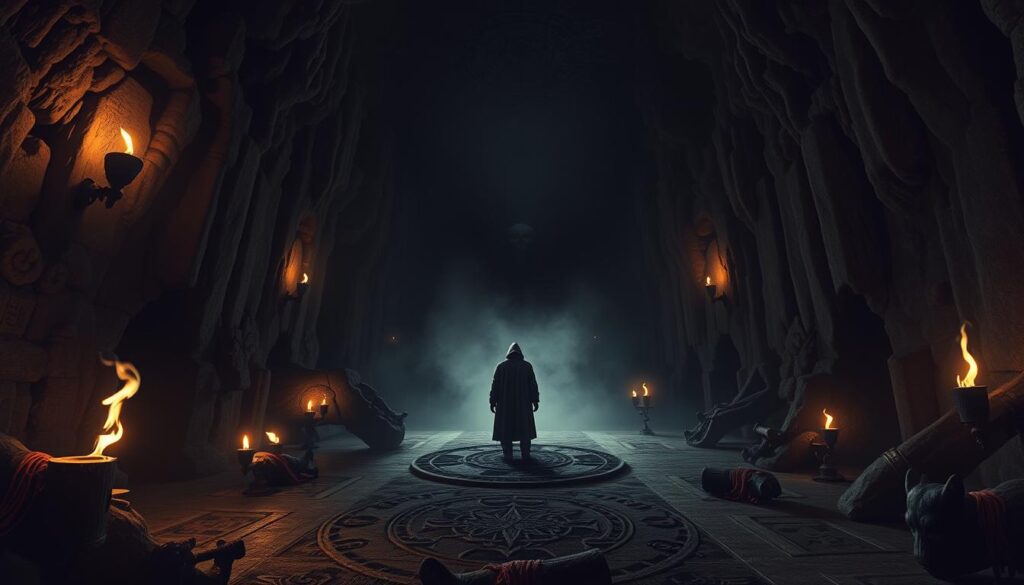I first found this story where story meets stone: a vaulted crypt beneath a vanished church in a historic Spanish city. I walked into a cool chamber and felt how a myth had taken root in actual masonry. That contrast shaped my view of the past.
The core tale describes a demonic tutor, a small group of pupils, and a sharp final forfeit after a fixed term. Those sharp images made the episode feel immediate to me, even across years and distance.
As I traced the name around Spain and Latin America, I saw how it grew into a shorthand for secret gatherings and magic. The site survives today as an archaeological place visitors can enter, and that survival helps me separate tradition from verifiable detail.
Key Takeaways
- I place the crypt at the heart of the tale and the city that shaped it.
- The compact cast and stakes make the myth feel vivid across time.
- The name spread into broader tradition about magic and secret places.
- The vaulted chamber anchors legend to real, visitable remains.
- I aim to trace origins, literary echoes, and how the story reached later culture.
How I First Met the Cave: A Past Shrouded in Stone and Story
The first time I entered that vaulted chamber, the city felt as if it had folded its history into a single cool room.
From church crypt to mythical classroom
I began by tracing the crypt that survives from the vanished church of San Cebrián. That small chamber is the cueva salamanca that drew my attention.
For years I mapped this place in my mind, linking it to streets, plazas, and the university façade nearby. The stone ribs and mortar read like a fragment of a larger plan.
- Literal foundation: the chamber is a practical part of a church complex.
- Narrative overlap: stories turned a simple crypt into a nocturnal classroom.
- Public access: the archaeological site makes the tale visitable and real.
According legend, a demonic tutor taught beneath that roof. That dual identity—sacred structure and secret school—stayed with me and shaped what I looked for next.
Legend of the Cave of Salamanca
Rumors held that seven pupils met at night beneath ancient stone to learn forbidden arts. I learned the tale as a tight, repeatable plot: seven students, seven years, and secret classes that ran by candlelight.

According to legend: seven students, seven years, and classes in the shadow of night
According legend, a compact course lasted one year and then repeated seven times. The rhythm made the story easy to pass along and hard to forget.
The devil as tutor: Asmodeus and the sacristan disguise in the cueva salamanca
Tradition names the devil as tutor, often Asmodeus. In some tellings he cloaked himself as a sacristan, which blurred church roles and forbidden instruction.
The draw at the end of the course: who stays to pay the debt
The course closed with a cruel draw. Chance chose which student remained as payment, making each year a gamble as well as a lesson.
The Marquis of Villena’s escape and the price of knowledge: a life without a shadow
I focus on Enrique de Aragón, the Marquis of Villena, because his escape is vivid. He fled but was said to live without shadow, a haunting image that kept the tale alive.
Versions and voices: Pierre de Axular, Clemente Potosí, and shifting parts
Other versions swap names. Some point to Pierre de Axular as the loser of the draw. Others place Clemente Potosí in a lecturer’s role. These shifts show how oral stories adapt.
City symbols that echo the myth: the frog on the University façade and student fortune
The University façade hides a toad on a skull. Students who miss it are said to fail. I read that as a moral emblem tied to the story’s warning: sight and judgment matter in both study and life.
Cervantes, Theater, and the Tale’s Long Shadow
Cervantes turned a local tale into a nimble stage trick that asked audiences to pick between laughter and belief.
Miguel Cervantes wrote the entremés “La cueva de Salamanca” as a short comic interlude that plays with trust. In brisk scenes he compresses time and stages misdirection so the audience doubts what they see.
Miguel de Cervantes’ entremés: humor, belief, and misdirection
His version uses sharp dialogue and swift parts to test gullibility. A single character’s swagger can tilt a room from credulity to mockery.
Early Modern paradox meets today
The piece treats showing and hiding like an early paradox. Modern stagings, such as a 2023 Hanover College production, highlight how that tension still speaks to questions about truth and performance.
Beyond Cervantes: other writers and a wider map
Juan Ruiz de Alarcón reworked the tale, shifting emphasis in his literature and giving new moral notes to the plot. Across years and seas, the name “salamanca” tagged places in Latin America tied to witchcraft and nocturnal rites.
- Quick effect: Cervantes compresses things into a small, effective theater piece.
- Adaptable: Each version reshapes which parts to show or hide.
- Lasting reach: The map of the myth moves from a single city into broader tradition.
Conclusion
, I find the story most persuasive because a tight plot matches a real place. According legend, the cave salamanca sits beneath San Cebrián, where a devil taught seven students in secret classes across seven years and closed each course with a cruel draw.
The image that stayed with me was the student who fled without shadow. That small motif gave the tradition its moral bite and kept the tale alive in theater and prose.
For me the cueva salamanca is both stone and device: it holds a clear set of parts—a few characters, one year repeated, a teacher in the dark—and it shows how time and retelling carry a tale far beyond its room.


Lascia un commento